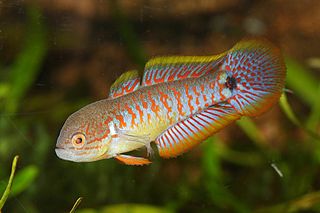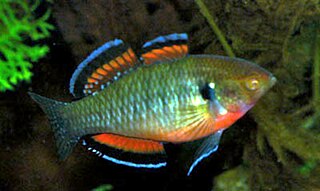
Lepidogalaxias salamandroides is a species of small freshwater fish of Western Australia. It is the only member of the family Lepidogalaxiidae and genus Lepidogalaxias. Common names for this fish include salamanderfish and Shannon mudminnow. Although it is not a lungfish, it resembles lungfish in several respects, including its ability to survive dry seasons by burrowing into the sand. It is on the IUCN Red List as Endangered.

The western carp gudgeon is one of several carp gudgeon species. Carp gudgeons are very small perciform fish found in the Australian Murray-Darling River system, mainly in lowland environments, but some have been observed in upland environments. They are often found in small creeks, as well as billabongs and the edges of larger rivers. They prefer water 1 to 2 m deep with aquatic weed and structure provided by rocks or sunken timber.

The common galaxias or inanga is a very widespread Southern Hemisphere fish in the family Galaxiidae. It is a slim, narrow fish with a forked tail and a mottled, spotty pattern, typically about 10 cm (4 in) long when fully grown. It lives in fresh water, but spawns at river mouths and spends the first six months of its life at sea, returning en masse in spring. Its vernacular names include cowfish, jollytail, common jollytail, eel gudgeon, inaka, native trout, pulangi, puye, slippery tarki, spotted minnow, Falklands minnow and whitebait.
The Tennessee dace is a species of ray-finned fish in the family Cyprinidae. It is found only in the United States; particularly in northeast Tennessee and southwest Virginia, and parts of extreme northwest Georgia. Until recently, they were considered a subspecies of mountain redbelly dace. They are commonly found in East Tennessee in spring fed first-order streams, often in silt and fine gravel pools, or undercut banks. These streams usually do not exceed two meters in width.

The mutton snapper is a species of marine ray-finned fish, a snapper belonging to the family Lutjanidae. It is found in the Western Atlantic Ocean.

Mogurnda is a genus of freshwater fishes in the family Eleotridae native to eastern and northern Australia and New Guinea. Several species are endemic to Lake Kutubu in Papua New Guinea.
The honey blue-eye is an endangered species of fish in the subfamily Pseudomugilinae. It is endemic to southeastern Queensland, Australia, where it is found in mildly acidic, often tannin-stained, ponds and streams in wallum habitat.

The channel darter is a species of freshwater ray-finned fish, a darter from the subfamily Etheostomatinae, part of the family Percidae, which also contains the perches, ruffes and pikeperches. It is native to North America where it typically occurs in the sandy or gravelly shallows of lakes and in small and medium-sized rivers in riffles over sand, gravel or rock bottoms. It is a small fish ranging from 34 to 72 mm in length, olive brown with darker speckles and sometimes with a dark spot below the eye and dark blotches along the flank. It feeds mostly on insect larvae and other small invertebrates and breeds in small streams. This species is listed as threatened by the Canadian Species at Risk Act (SARA) but overall it has a wide range and numerous sub-populations and the International Union for Conservation of Nature has rated it as a "least concern species".

The potato grouper, also called the potato cod or potato bass, is a species of marine ray-finned fish, a grouper from the subfamily Epinephelinae which is part of the family Serranidae, which also includes the anthias and sea basses. It has a wide Indo-Pacific distribution.
Lake Lenthall is a lake created by the Lenthalls Dam in Duckinwilla, Fraser Coast Region, Queensland, Australia. As a result of a 518 square kilometres (200 sq mi) catchment, it takes a short time in moderate rain events to fill Lake Lenthall to 100% capacity.

The hornyhead chub is a small species of minnow in the family Cyprinidae of order Cypriniformes. It mainly inhabits small rivers and streams of the northern central USA, up into Canada. The adults inhabit faster, rocky pools of rivers.

The peacock gudgeon or peacock goby is a tropical freshwater species of fish in the family Eleotridae that is endemic to the eastern part of Papua New Guinea. It can be found in schools hovering over the substrate in rivers and ponds. This species can reach a length of 7.5 cm (3.0 in). It is currently the only known member of its genus.

The ironcolor shiner is a species of freshwater ray-finned fish from the family Cyprinidae, the minnows and carps. It is a widespread species in streams and rivers in eastern North America.

Mogurnda adspersa is a species of endangered gudgeon that is endemic to south-eastern mainland Australia. The fish is brown, although the shade becomes lighter near its abdomen. Spots of various colours occur on its sides. After a dramatic population decline in the late 20th century, the fish was thought to be locally extinct in several areas, but was rediscovered both in South Australia and Victoria in the 21st century. Various state governments, the Murray-Darling Basin Authority, and various volunteer organisations have been taking measures to increase the fish's numbers.

Hypseleotris compressa, the empire gudgeon, is a species of Gobiiform fish in the family Eleotridae endemic to Australia and south-central New Guinea.

Terapon theraps, the largescaled terapon, banded grunter, banded trumpeter, flagtail grunter, flagtail trumpeter, large-scaled grunter-perch, northern grunter and spiky trumpeter, is a species of marine ray-finned fish, a grunter from the family Terapontidae. This species has a wide distribution in the Indo-Pacific region.
Bidyanus welchi, commonly known as Welch's grunter, black bream, or silver bream, is a species of freshwater ray-finned fish from the family Terapontidae native to Australia.

Terapon puta, the spiny-checked grunter, three-lined grunter, small-scaled banded grunter, small-scaled terapon, squeaking perch or two-lined grunter, is a species of fish from the Indo-Pacific region, it is a member of the grunter family, Terapontidae. It has also spread into the eastern Mediterranean Sea from the Red Sea through the Suez Canal, a process known as Lessepsian migration.
Galaxias terenasus, the roundsnout galaxias, is a galaxiid of the genus Galaxias, a member of the Mountain Galaxias species complex group of freshwater fish, found in Australia.
Oxyeleotris nullipora, the poreless gudgeon, is a gudgeon of the genus Oxyeleotris, a freshwater fish found in Australia and Papua New Guinea.














